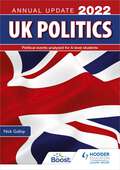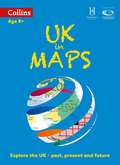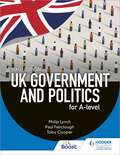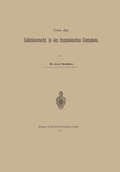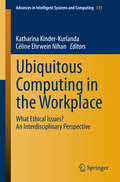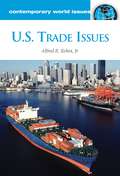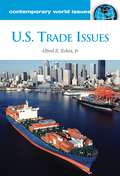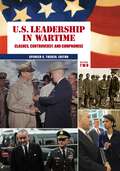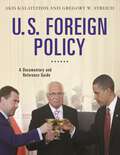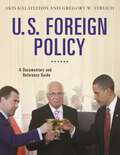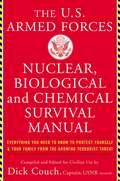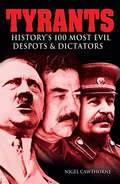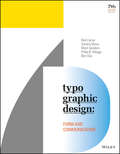- Table View
- List View
UK Politics Annual Update 2022
by Nick GallopThis UK Politics Annual Update will help students:- Review all the developments relevant to A-level specifications in UK politics from the last year, with examples linked closely to specification points, strong links between topics and focused suggestions for further reading- Develop their confidence with expert analysis they can draw on throughout their course and in the exams- Enhance their knowledge of the news to build a bank of up-to-date examples linked to the specifications, helping them to develop persuasive arguments for their essays- Learn more about the government's response to the COVID-19 pandemic and other up-to-date political developments, and how to put them into context- Use our updated exam skills feature to clarify how to use the information they have just learned in their examUK Politics Annual Update 2022 chapters:1. Pressure groups: Lobbying in the 2020s - methods and controversies2. Rights in context: Campaigns to protect liberties and to extend the franchise3. Political Parties: Old, new or in between? What does Keir Starmer's Labour Party stand for?4. The constitution: The Johnsonian constitution 'in flux' 5. Devolution (Part 1): See no EVEL: what is the future for English representation in Westminster?6. Devolution (Part 2): What does the government's 'levelling up' agenda mean for devolved government in England?7. Parliament and the executive: The changing relationship between Parliament and the executive8. The House of Lords: Peers in the 2020s: The composition and legislative influence of the House of Lords9. The UK Supreme Court: Redefining judicial power in the 2020s
UK Politics Annual Update 2022
by Nick GallopThis UK Politics Annual Update will help students:- Review all the developments relevant to A-level specifications in UK politics from the last year, with examples linked closely to specification points, strong links between topics and focused suggestions for further reading- Develop their confidence with expert analysis they can draw on throughout their course and in the exams- Enhance their knowledge of the news to build a bank of up-to-date examples linked to the specifications, helping them to develop persuasive arguments for their essays- Learn more about the government's response to the COVID-19 pandemic and other up-to-date political developments, and how to put them into context- Use our updated exam skills feature to clarify how to use the information they have just learned in their examUK Politics Annual Update 2022 chapters:1. Pressure groups: Lobbying in the 2020s - methods and controversies2. Rights in context: Campaigns to protect liberties and to extend the franchise3. Political Parties: Old, new or in between? What does Keir Starmer's Labour Party stand for?4. The constitution: The Johnsonian constitution 'in flux' 5. Devolution (Part 1): See no EVEL: what is the future for English representation in Westminster?6. Devolution (Part 2): What does the government's 'levelling up' agenda mean for devolved government in England?7. Parliament and the executive: The changing relationship between Parliament and the executive8. The House of Lords: Peers in the 2020s: The composition and legislative influence of the House of Lords9. The UK Supreme Court: Redefining judicial power in the 2020s
UK Politics Annual Update 2021
by Nick GallopYou can use this Annual Update for tasks throughout your course and for help with examination questions.- Review all the developments relevant to A-level specifications in UK politics from the last year, with examples linked closely to specification points, strong links between topics and focused suggestions for further reading- Develop your confidence with expert analysis you can draw on both throughout your course and in the exams- Enhance your knowledge of the news to build a bank of up-to-date examples linked to the specifications, helping you to develop persuasive arguments for your essays- Learn more about the government's response to the COVID-19 pandemic and other up-to-date political developments, and how to put them into contextTable of contents: UK update 20211. Legitimacy and the lockdown: from health crisis to democratic crisis?2. The Black Lives Matter movement: pressure, protest and controversy3. Individual and collective rights: civil liberties campaigns in the 2020s4. Political parties in the 2020s: funding, fairness and the future5. Influence of the media: Is the BBC biased and does it matter?6. Devolution and health crisis7. The House of Lords: too big, too partisan and time for change?8. What impact did the health crisis have on the relationship between parliament and the executive?9. Controlling the health crisis: how effective was Boris Johnson in dictating events and determining policy?
UK In Maps (PDF)
by Stephen Scoffham Collins Maps StaffCollins UK in Maps is a multi-topic atlas of the UK, which introduces the most relevant topics to reflect the Geography Key Stage 2-3 requirements of the National Curriculum. Formerly published as Collins Keystart UK Atlas, this collection of maps can be used to investigate different themes and topics. It tells a story in maps, diagrams, charts, words and photographs each of which presents information to compare and examine. We live on a remarkable planet and this atlas helps us to make sense of the UK today and understand how things came to be as well as how they might change in years to come. Suggested activities on each spread encourage users to explorer further.
UK Government and Politics for A-level Sixth Edition
by Philip Lynch Paul Fairclough Toby Cooper Eric Magee- Comprehensive coverage and analysis of relevant political developments helps develop students' knowledge and key skills-Up-to-date examples, case studies and debate feature will improve students' grasp of contemporary developments in UK politics-Includes more synoptic links to help students understand how different topics within the A-level link together -Includes quickfire knowledge-check questions and summaries of key content to help consolidate knowledge and understanding -Features exam-style questions throughout, helping students improve their analysis and evaluation skills-Provides answer guidance for exam-style questions online at www.hoddereducation.co.uk/xxx
Ubiquitous Computing in the Workplace: What Ethical Issues? An Interdisciplinary Perspective (Advances in Intelligent Systems and Computing #333)
by Katharina Kinder-Kurlanda Céline Ehrwein NihanThis book provides an interdisciplinary collection of views on the ethical challenges and opportunities of workplaces in the Internet of things. Current developments within Ubiquitous computing (ubicomp) systems designed for the workplace are introduced and philosophical, organizational and socio-ethical considerations of ubicomp in workplaces are provided. Suggestions regarding the rules that should be respected in order to favor an adequate implementation of ubicomp in the workplace are offered, considering both intra-organizational but also wider societal concerns. The interdisciplinary collection of contributions invites the reader to engage in the discussion of ubicomp in everyday working environments.
U.S. Trade Issues: A Reference Handbook (Contemporary World Issues)
by Alfred E. Jr.An expert analysis of key issues, individuals, and developments in U.S. trade policy from national, regional, and global perspectives.What is the proper balance between free trade and protecting the American economy? U.S. Trade Issues: A Reference Handbook is a timely exploration of this vital and politically sensitive question, one that emerged as a crucial issue in the 2008 presidential election. Written by a former chairman of the U.S. International Trade Commission, it provides an authoritative, accessible, and unbiased review of the defining events, principal players, and key controversies in U.S. trade policy.U.S. Trade Issues describes American trade policies from the days of the republic to the present, focusing most intently on the post-World War II era. It explores a number of current issues, including the Doha Round of Multilateral Negotiations, NAFTA, and the president's trade authority. In addition, the handbook looks at American trade policy in the context of an increasingly globalized world economy.
U.S. Trade Issues: A Reference Handbook (Contemporary World Issues)
by Alfred E. Jr.An expert analysis of key issues, individuals, and developments in U.S. trade policy from national, regional, and global perspectives.What is the proper balance between free trade and protecting the American economy? U.S. Trade Issues: A Reference Handbook is a timely exploration of this vital and politically sensitive question, one that emerged as a crucial issue in the 2008 presidential election. Written by a former chairman of the U.S. International Trade Commission, it provides an authoritative, accessible, and unbiased review of the defining events, principal players, and key controversies in U.S. trade policy.U.S. Trade Issues describes American trade policies from the days of the republic to the present, focusing most intently on the post-World War II era. It explores a number of current issues, including the Doha Round of Multilateral Negotiations, NAFTA, and the president's trade authority. In addition, the handbook looks at American trade policy in the context of an increasingly globalized world economy.
U.S. Leadership in Wartime [2 volumes]: Clashes, Controversy, and Compromise [2 volumes]
A historical study of the relationship between civilian and military leaders in the United States during wartime, from the American Revolution to the Iraq War.Now from one of the world's leading publishers of military history comes a breakthrough reference on one of the most important and complex aspects of U.S. national defense. U.S. Leadership in Wartime: Clashes, Controversy, and Compromise offers a comprehensive analysis of the characteristics that constitute effective leadership in war and discusses the often contentious relationships between U.S. civilian and military leadership throughout American history.U.S. Leadership in Wartime focuses on ten conflicts, including the Revolutionary War, the Civil War, World Wars I and II, the Vietnam War, the Iraq War, and the war in Afghanistan. Coverage for each conflict focuses on the dynamics of civilian-military relations and their impact on the course, outcome, and perception of each war under discussion. Coverage in each chapter includes an overview essay, sidebars, and detailed treatments of key engagements and battles, as well as detailed biographical essays of important figures—not just politicians and generals, but also labor leaders, business leaders, journalists, and women.
U.S. Foreign Policy and the New International Economic Order: Negotiating Global Problems, 1974-1981 (Bloomsbury Academic Collections: Economics)
by Robert K. OlsonU.S. Foreign Policy and the New International Economic Order is an authoritative account of the development of U.S. policy toward the New International Economic Order (NIEO) from its inception in 1974 through the Eleventh Special Session of the General Assembly in August-September 1980. Olson concentrates on the latter stages of the North-South dialogue, analyzing U.S. policy in the context of broad foreign policy objectives pursued since the end of World War II and also in light of the events of the seventies and the 1980 Soviet invasion of Afghanistan. On the premise that policy is, ultimately, what happens at the negotiating table, he also specifically examines the record of U.S. negotiations on the Common Fund, UNCTAD V, and other major North-South meetings during 1979-1980. This material, together with an examination of how policy is made within the U.S. bureaucracy, who makes it, and why, provides fresh insight into a complex process.Olson seeks to determine if and to what extent U.S. policy serves basic U.S. interests and whether the negotiating process has been an effective medium for global problem solving. He concludes that althought U.S. policy and practice do serve traditional U.S. foreign policy interests, the political cost is high. He also concludes that NIEO negotiations have not been an effective means for global problem solving and that rapid change in political and economic realities has rendered obsolete the basic concepts – the very mechanisms for problem solving – on both sides.
U.S. Foreign Policy: A Documentary and Reference Guide (Documentary and Reference Guides)
by Akis Kalaitzidis Gregory W. StreichA critical tool for the study of U.S. history, this volume offers an analysis of important documents and decisions in U.S. foreign policy from George Washington to Barack Obama.The study of historical primary documents provides a uniquely beneficial and insightful view into history. To that end, U.S. Foreign Policy: A Documentary and Reference Guide presents and interprets important documents from throughout U.S. history, from the administration of George Washington to that of Barack Obama. Examining U.S. foreign policy through this lens identifies the ideals of the United States during different periods, illuminates the intent behind its military actions, and reveals how each American president interpreted his moral responsibilities as leader of one of the most powerful nations in the world.Organized to allow readers to examine the historical evolution of U.S. foreign policy, the book includes treaties, speeches, and other documents that illustrate important doctrines and decisions over the more than two centuries of American history, covering all presidential doctrines to the current administration. It also highlights various phases of foreign policy, from regionalism to westward expansion, from the Cold War to a New World Order. In addition to the documents themselves, the authors provide invaluable analysis and commentary that will help students understand what the documents mean—both in the context of their time, and in terms of their broader historical significance.
U.S. Foreign Policy: A Documentary and Reference Guide (Documentary and Reference Guides)
by Akis Kalaitzidis Gregory W. StreichA critical tool for the study of U.S. history, this volume offers an analysis of important documents and decisions in U.S. foreign policy from George Washington to Barack Obama.The study of historical primary documents provides a uniquely beneficial and insightful view into history. To that end, U.S. Foreign Policy: A Documentary and Reference Guide presents and interprets important documents from throughout U.S. history, from the administration of George Washington to that of Barack Obama. Examining U.S. foreign policy through this lens identifies the ideals of the United States during different periods, illuminates the intent behind its military actions, and reveals how each American president interpreted his moral responsibilities as leader of one of the most powerful nations in the world.Organized to allow readers to examine the historical evolution of U.S. foreign policy, the book includes treaties, speeches, and other documents that illustrate important doctrines and decisions over the more than two centuries of American history, covering all presidential doctrines to the current administration. It also highlights various phases of foreign policy, from regionalism to westward expansion, from the Cold War to a New World Order. In addition to the documents themselves, the authors provide invaluable analysis and commentary that will help students understand what the documents mean—both in the context of their time, and in terms of their broader historical significance.
U.S. Armed Forces Nuclear, Biological And Chemical Survival Manual
by Captain George GaldorisiIn this comprehensive guide, military experts teach you how to survive an attack on American soil, from North Korean missiles to weaponized smallpoxNorth Korean nukes. Emerging epidemic and pandemic disease. Dirty bombs in train stations. Chemical warfare. Americans have more reasons than ever to be afraid. If a nuclear missile strikes, will you know what to do? If a nerve agent is released in your office building, will you know the best way to avoid harm? The U.S. Armed Forces Nuclear, Biological and Chemical Survival Manual gives you the information you need to survive a terrorist attack. It contains the best practices of all the United States' military services, adapted for the first time for civilian use. Experts agree that the threats posed by terrorists and enemy nations have never been graver. This handbook is the single most effective tool you can own to protect yourself and your family against the danger looming over our homeland.This manual will show you how to:- Protect yourself during a chemical or biological attack- Recognize the indicators of nuclear, chemical and biological attack- Develop a simple and effective family action plan- Guard against the radiological effects of a dirty bomb- Assist victims of nuclear, chemical, or biological agents- Assemble and store the everyday materials that could save your life
Tyrants: History's 100 Most Evil Despots & Dictators
by Nigel Cawthorne"I have committed many acts of cruelty and had an incalculable number of men killed, never knowing whether what I did was right. But I am indifferent to what people think of me."- Genghis KhanA spine-chilling chronicle of dictators and their crimes against humanity, Tyrants introduces the most bloodthirsty madmen - and women - ever to wield power over their unfortunate fellow human beings.From Herod the Great, persecutor of the infant Jesus, to Adolf Hitler, mass murderer and instigator of the most devastating war the world has ever known, this book examines history's most infamous despots and tells in vivid detail the story of the lives they led, their ruthless climb to the top and the destruction and sorrow they left in their wake.Unflinching in its coverage, Tyrants is a gripping and compelling portrait of the darker side of politics and power, revealing the strange and grisly stories behind the world's most infamous autocrats.
Typographic Design: Form and Communication
by Rob Carter Sandra Maxa Mark Sanders Philip B. Meggs Ben DayThe bestselling introduction to designing the written word Typographic Design: Form & Communication is the definitive reference for graphic designers, providing a comprehensive introduction to the visual word. Done well, typopgraphy can communicate so much more than the words themselves. Typographic design determines how you feel about a message, the associations you make, and ultimately, the overall success of the communication. Typographic design extends from the page to the screen, and is a critical element of almost any graphic design project. This book provides essential guidance on everything related to type: from letterforms and negative space, to messaging, processes, and history, aspiring designers will find great utility in mastering these critical concepts. This new seventh edition has been fully updated with new coverage of contemporary typography processes, updated case studies, and new examples from branding, print, web, motion, and more. On-screen typographic design concepts are discussed in greater detail, and the online supplemental materials include new flashcards, terminology and quizzes. Understand design factors as they relate to type Explore communication and typographic messaging Learn how typography has evolved, and where it is headed Adopt established approaches to designing with type The irony of typographic design is that, when done well, it often goes unnoticed—but its impact on a project’s overall success is undeniable. Typography can make or break a page, can enhance or overpower an image, and can obscure a message or bring it into sharp focus. It is one of the most powerful tools in the graphic designer’s arsenal, and Typographic Design is the complete, practical introduction.
Typing Indian Languages Using Physical Keyboard - Tutorial
by Bookshare IndiaTyping in Android using touch screen keyboard is always difficult, especially for a person with visual impairment. This is a tutorial for typing using physical keyboard. It provides a solution for both kinds of typing, that is, phonetic as well as traditional [Native].
The Type Theory of Law: An Essay in Psychoanalytic Jurisprudence (SpringerBriefs in Law)
by Marko NovakThis volume presents a Type Theory of Law (TTL), claiming that this is a unique theory of law that stems from the philosophical understanding of Jung’s psychological types applied to the phenomenon of law. Furthermore, the TTL claims to be a universal, general and descriptive account of law. To prove that, the book first presents the fundamentals of Jungian psychological types, as they had been invented by Jung and consequently developed further by his followers. The next part of the book describes how the typological structure of an individual determines their understanding of law. It then addresses the way in which inclusive legal theory can be understood based on this typology. Finally, the book describes the TTL in general and descriptive terms and puts it into context. All in all, the book shows how the integral or inclusive approach to understanding the nature of law is not only in tune with our time, but also relevant for presenting a more persuasive picture of law than the older exclusivist or dualist approaches of strict natural law and rigid legal positivism did.
Type 7 & generic plastic recycling symbols (UEB Uncontracted)
by RnibOn this page, there are two symbols from the set of resin identity codes developed by the US Society of the Plastics Industry (SPI) in 1988. They are intended to enable recyclers to sort plastic refuse easily for reprocessing. They are used internationally. There is a locator dot shown, which will be at the top left of the page when the image is the correct way up. Each symbol consists of three clockwise chasing arrows arranged in a triangular shape with the point at the top. The symbol for type 7 plastic is in the top left of the page. It has a print number 7 inside. It is labelled OTHER for other plastics, including acrylic, fiberglass, nylon, polycarbonate, and polylactic acid (a bioplastic), and multilayer combinations of different plastics. The symbol for other materials is in the bottom right of the page. It is not labelled and does not have a print number inside. The material should be described in text.
Type 7 & generic plastic recycling symbols (UEB Contracted)
by RnibOn this page, there are two symbols from the set of resin identity codes developed by the US Society of the Plastics Industry (SPI) in 1988. They are intended to enable recyclers to sort plastic refuse easily for reprocessing. They are used internationally. There is a locator dot shown, which will be at the top left of the page when the image is the correct way up. Each symbol consists of three clockwise chasing arrows arranged in a triangular shape with the point at the top. The symbol for type 7 plastic is in the top left of the page. It has a print number 7 inside. It is labelled OTHER for other plastics, including acrylic, fiberglass, nylon, polycarbonate, and polylactic acid (a bioplastic), and multilayer combinations of different plastics. The symbol for other materials is in the bottom right of the page. It is not labelled and does not have a print number inside. The material should be described in text.
Type 7 & generic plastic recycling symbols (Large Print)
by RnibOn this page, there are two symbols from the set of resin identity codes developed by the US Society of the Plastics Industry (SPI) in 1988. They are intended to enable recyclers to sort plastic refuse easily for reprocessing. They are used internationally. There is a locator dot shown, which will be at the top left of the page when the image is the correct way up. Each symbol consists of three clockwise chasing arrows arranged in a triangular shape with the point at the top. The symbol for type 7 plastic is in the top left of the page. It has a print number 7 inside. It is labelled OTHER for other plastics, including acrylic, fiberglass, nylon, polycarbonate, and polylactic acid (a bioplastic), and multilayer combinations of different plastics. The symbol for other materials is in the bottom right of the page. It is not labelled and does not have a print number inside. The material should be described in text.
Type 5 & 6 plastic recycling symbols (UEB Uncontracted)
by RnibOn this page, there are two symbols from the set of resin identity codes developed by the US Society of the Plastics Industry (SPI) in 1988. They are intended to enable recyclers to sort plastic refuse easily for reprocessing. They are used internationally. There is a locator dot shown, which will be at the top left of the page when the image is the correct way up. Each symbol consists of three clockwise chasing arrows arranged in a triangular shape with the point at the top. The triangle has a print character number inside and an abbreviation for the plastic type in upper case print characters down the page. The symbol for type 5 plastic is in the top left of the page. It is labelled PP for Polypropylene. The symbol for type 6 plastic is in the bottom right of the page. It is labelled PS for Polystyrene.
Type 5 & 6 plastic recycling symbols (UEB Contracted)
by RnibOn this page, there are two symbols from the set of resin identity codes developed by the US Society of the Plastics Industry (SPI) in 1988. They are intended to enable recyclers to sort plastic refuse easily for reprocessing. They are used internationally. There is a locator dot shown, which will be at the top left of the page when the image is the correct way up. Each symbol consists of three clockwise chasing arrows arranged in a triangular shape with the point at the top. The triangle has a print character number inside and an abbreviation for the plastic type in upper case print characters down the page. The symbol for type 5 plastic is in the top left of the page. It is labelled PP for Polypropylene. The symbol for type 6 plastic is in the bottom right of the page. It is labelled PS for Polystyrene.
Type 5 & 6 plastic recycling symbols (Large Print)
by RnibOn this page, there are two symbols from the set of resin identity codes developed by the US Society of the Plastics Industry (SPI) in 1988. They are intended to enable recyclers to sort plastic refuse easily for reprocessing. They are used internationally. There is a locator dot shown, which will be at the top left of the page when the image is the correct way up. Each symbol consists of three clockwise chasing arrows arranged in a triangular shape with the point at the top. The triangle has a print character number inside and an abbreviation for the plastic type in upper case print characters down the page. The symbol for type 5 plastic is in the top left of the page. It is labelled PP for Polypropylene. The symbol for type 6 plastic is in the bottom right of the page. It is labelled PS for Polystyrene.
Type 3 & 4 plastic recycling symbols (UEB Uncontracted)
by RnibOn this page, there are two symbols from the set of resin identity codes developed by the US Society of the Plastics Industry (SPI) in 1988. They are intended to enable recyclers to sort plastic refuse easily for reprocessing. They are used internationally. There is a locator dot shown, which will be at the top left of the page when the image is the correct way up. Each symbol consists of three clockwise chasing arrows arranged in a triangular shape with the point at the top. The triangle has a print character number inside and an abbreviation for the plastic type in upper case print characters down the page. The symbol for type 3 plastic is in the top left of the page. It is labelled V for Polyvinyl chloride. The symbol for type 4 plastic is in the bottom right of the page. It is labelled LDPE for Low-density polyethylene.

